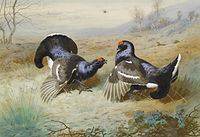
Photo from wikipedia
The importance of examining multiple hierarchical levels when modeling resource use for wildlife has been acknowledged for decades. Multi-level resource selection functions have recently been promoted as a method to… Click to show full abstract
The importance of examining multiple hierarchical levels when modeling resource use for wildlife has been acknowledged for decades. Multi-level resource selection functions have recently been promoted as a method to synthesize resource use across nested organizational levels into a single predictive surface. Analyzing multiple scales of selection within each hierarchical level further strengthens multi-level resource selection functions. We extend this multi-level, multi-scale framework to modeling resistance for wildlife by combining multi-scale resistance surfaces from two data types, genetic and movement. Resistance estimation has typically been conducted with one of these data types, or compared between the two. However, we contend it is not an either/or issue and that resistance may be better-modeled using a combination of resistance surfaces that represent processes at different hierarchical levels. Resistance surfaces estimated from genetic data characterize temporally broad-scale dispersal and successful breeding over generations, whereas resistance surfaces estimated from movement data represent fine-scale travel and contextualized movement decisions. We used telemetry and genetic data from a long-term study on pumas (Puma concolor) in a highly developed landscape in southern California to develop a multi-level, multi-scale resource selection function and a multi-level, multi-scale resistance surface. We used these multi-level, multi-scale surfaces to identify resource use patches and resistant kernel corridors. Across levels, we found puma avoided urban, agricultural areas, and roads and preferred riparian areas and more rugged terrain. For other landscape features, selection differed among levels, as did the scales of selection for each feature. With these results, we developed a conservation plan for one of the most isolated puma populations in the U.S. Our approach captured a wide spectrum of ecological relationships for a population, resulted in effective conservation planning, and can be readily applied to other wildlife species.
Journal Title: PLoS ONE
Year Published: 2017
Link to full text (if available)
Share on Social Media: Sign Up to like & get
recommendations!